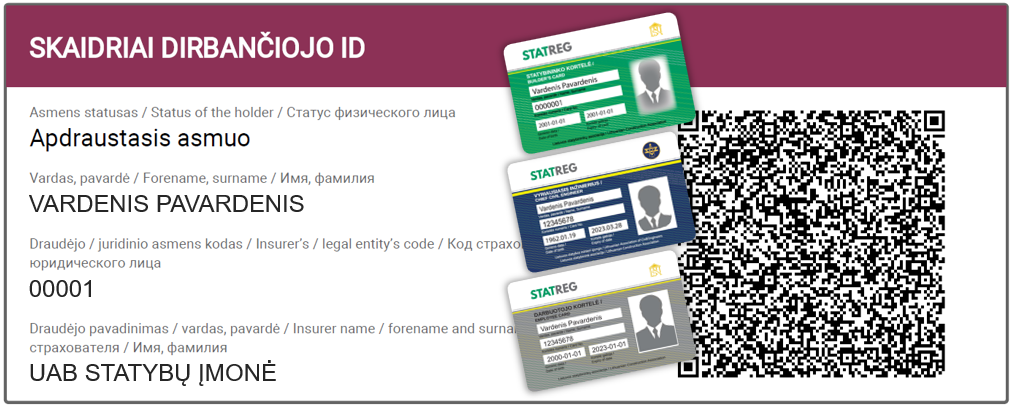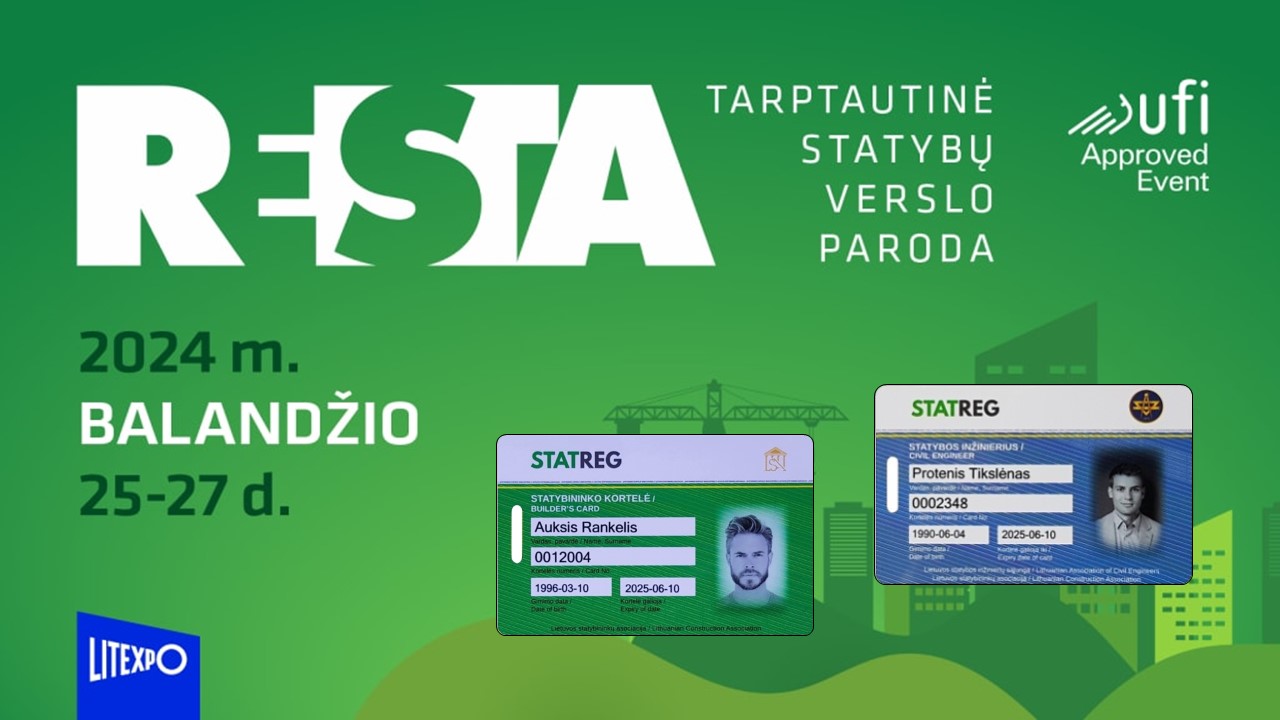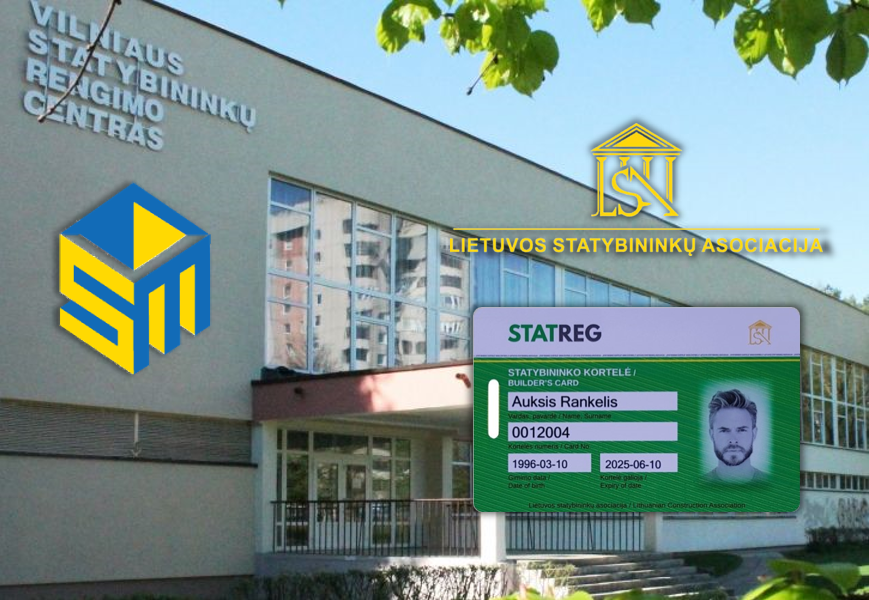NEWS
The State Labor Inspectorate informs
November 26, 2024. The State Labor Inspectorate informs that all employees performing construction work must have a transparent worker ID. The builder (client) must also ensure that all individuals performing construction work have valid codes. More information can be found here.
We remind STATREG users that if you stop working or change jobs, you need to update this information in your STATREG profile, in the work experience section, or inform the STATREG administration at the email address info@statreg.lt.
All STATREG users can easily and free of charge import a Transparent Employee ID (SDID) into their Builder or Engineer card!
Company representatives in the STATREG system can immediately import the SDIDs of all their employees into their STATREG cards with just a few clicks.
Learn more...
Exhibition RESTA 2024 with STATREG card for free!
April 5, 2024. The international and largest construction business exhibition in the Baltic States RESTA is back! For the third year in a row, the Lithuanian Association of Construction invites all professionals with STATREG Builder or Construction Engineer cards to visit the RESTA 2024 exhibition for free!
When coming to the exhibition, you must have a STATREG Builder's or Engineer's card with you and present it at the entrance.
More information about the exhibition can be found here.
The best graduates of the Vilnius Builder Training Center will receive not only a diploma, but also a Builder's Card!
March 4, 2024. This is a new phase of cooperation between VSRC and LSA.
From now on, all the most advanced students of the Vilnius Builders' Training Center, who have successfully passed the final exams, will receive their STATREG Builder's card for free!
A builder's card is not only a tool for a professional builder, but also a document confirming qualifications that will facilitate the integration of newly graduated builders into the labor market.
Three more "ten point holders” - this time at the site of UAB YIT Lietuva
September 2, 2020. The first assessments at the Yit Lietuva UAB site did not disappoint - even three foremen demonstrated strong knowledge and skills worth 10 points: Artūras Siauka (Installation of gypsum board partitions), Arvydas Jasiulis (Installation of gypsum board partitions) and Vytautas Kuncaitis (Installation of rendered facades systems).With the newcomers, total 15 "ten point holders" are registered in the STATREG system today.
About competencies
Each competency stems from construction works or activities defined in STR 1.06.01:2016 "Construction works. Supervising the construction of a structure" and the needs of employers or employees to demonstrate their competences.
The Lithuanian Association of Construction prepares descriptions of competences according to the classification of construction works established by the regulation, the professional standard of the construction sector, supplementing them with explanations and clarifications from employers.
Each competency is linked to one or more competency areas. Areas of competence are associated with one or more qualifications of II-V levels of construction workers. The description of each competence defines the competence and its limits, taking into account the perceived level of the employee.
Some competencies may be subject to limited validity, e.g. state-regulated work safety qualifications (certificates) or competences are necessary for the approval of some competences. At the end of the limited validity, the person submits a request for a new competence in his statreg.lt account. Competence is evaluated and confirmed in the same order as for the first time. If the competence description, name, evaluation questions and tasks have been changed during that time, the evaluation is carried out according to the valid documents.
Competence - the proven ability to use knowledge and skills in performing certain activities or achieving intended results.
Qualification - the totality of a person's competences or professional experience and the competences required for a certain activity are recognized in accordance with the procedure established by legal acts.
Qualification level - as determined in the appendix of the description of the structure of Lithuanian qualifications (revision of resolution No. 986 of the Government of the Republic of Lithuania of August 24, 2011).
Level I
Qualification is for activities consisting of one or more simple specialized actions or operations. When performing the activity, one is able to apply the basic knowledge specific to the activity being performed.
The working environment is clear, the activities are carried out according to detailed instructions, in some cases intensive supervision, guidance and support are necessary.
The situations, actions and operations that make up an activity are constant and constantly repeated.
Level II
The qualification focuses on activities consisting of actions and operations designed to solve simple problems. When performing the activity, one is able to apply the basic factual knowledge specific to the activity.
Activities require supervision, guidance and assistance.
The actions and operations that make up an activity are constant.
Level III
The qualification is intended for activities consisting of actions and operations in narrow areas of activity. Activities may include several or more specialized operational tasks that require the application of well-known and tested solutions. When performing the activity, one is able to apply the knowledge about the facts, principles and processes of the field of activity specific to the activity being performed.
The activity is performed independently under the guidance of a highly qualified employee and under external control of the quality of performance.
The work environment may require the ability to adapt to simple changes in context.
Level IV
The qualification is intended for activities consisting of actions and operations in relatively broad fields of activity. The activity is carried out by carrying out several and more specialized activity tasks, the possible solutions of which are not always tested and known. Ability to apply factual and theoretical knowledge specific to the broad context related to the field of activity.
The activity is performed independently, taking responsibility for the quality of the procedures and results of the activity. After gaining experience, the qualification allows to transfer practical operational skills to lower qualified employees and to supervise their activities.
The operating environment requires the ability to adapt to changes that result from changes in the operating context, which are usually predictable.
Level V
The qualification is intended for activities characterized by a complex combination of operational tasks in different areas of activity. Activities include assessing and training the competencies of lower-skilled workers. The activity requires combining detailed knowledge of the field of activity with general knowledge in solving various specialized operational tasks in several different fields of activity.
The employee performs the activity independently, its supervision is limited only to the assessment of the results. The tasks of the activity are determined by a higher qualified employee, often giving the performer the opportunity to choose the methods and means of solving these tasks. The employee manages the activities of lower-qualified employees, plans and distributes activity tasks, supervises the performance of activities, advises and checks the quality of performance of activities.
The technological and organizational requirements of the activity and its environment are constantly changing, changes are often unpredictable and may be related to new areas of activity.
Levels VI, VII and VIII
Defines the qualifications of engineers.



